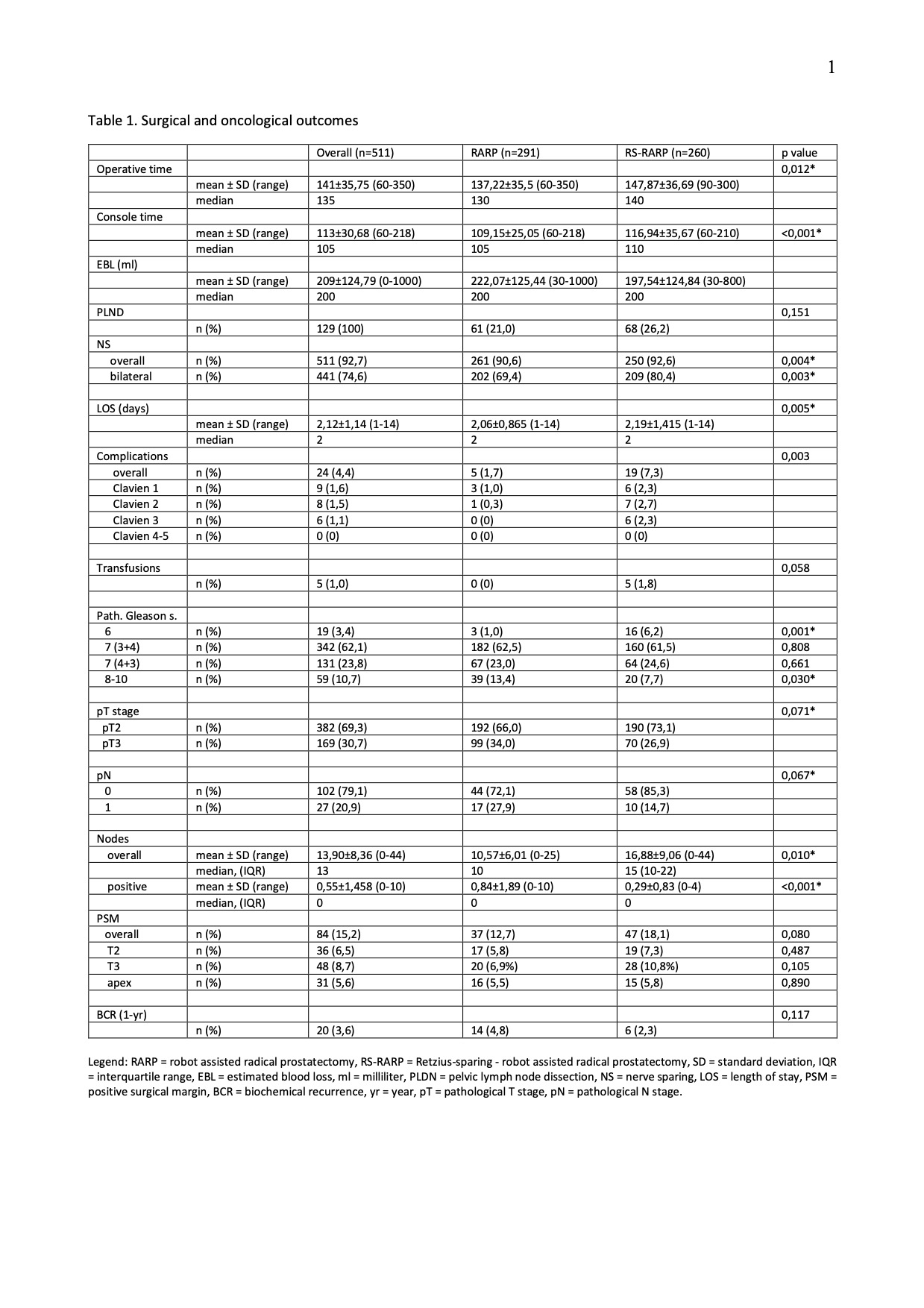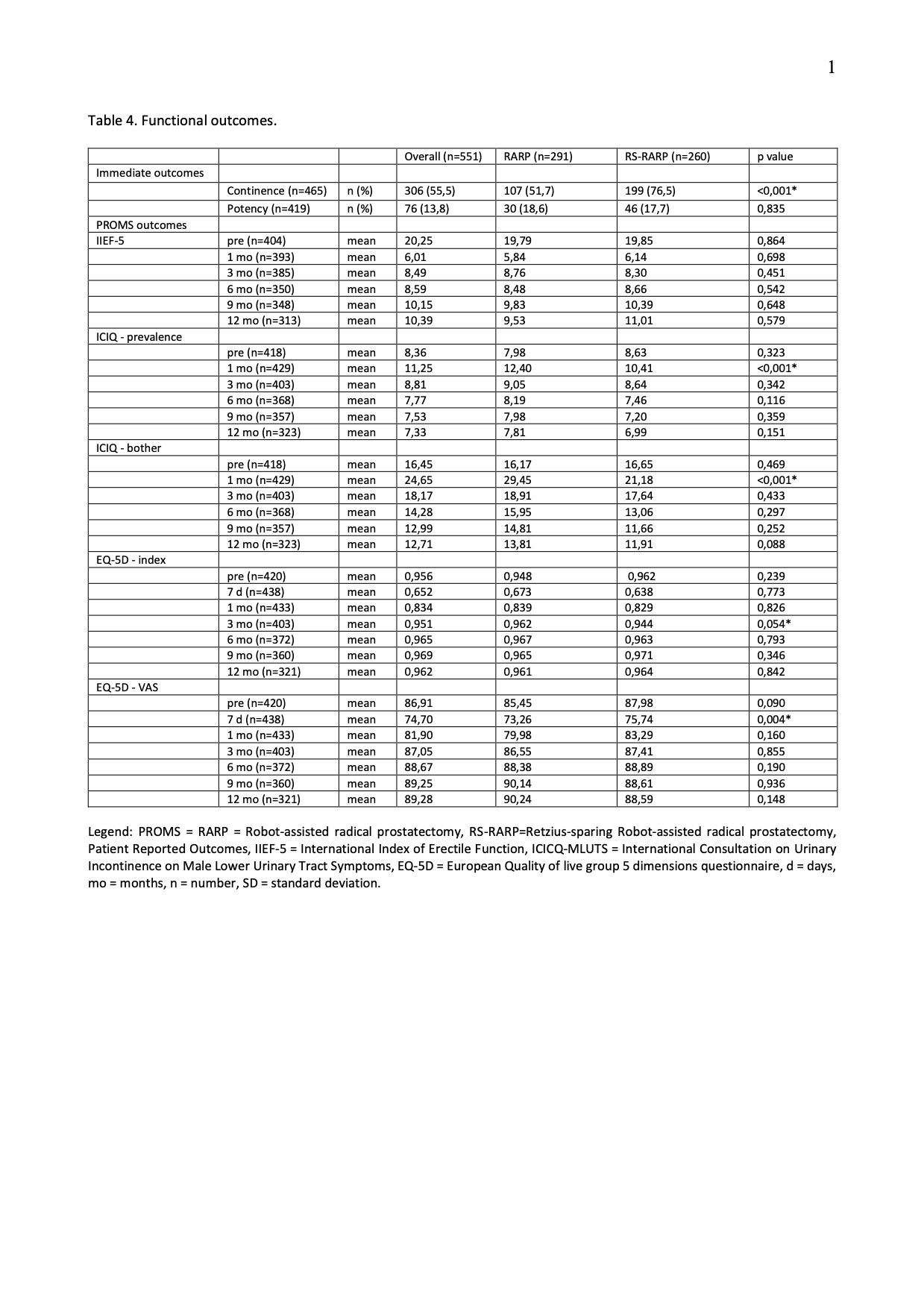Back
Poster, Podium & Video Sessions
Moderated Poster
MP15: Prostate Cancer: Localized: Surgical Therapy I
MP15-17: Retzius-Sparing Robot Assisted Radical Prostatectomy has similar 1-year functional and oncological outcomes as Standard Robot-Assisted Radical Prostatectomy: results from a high volume UK centre
Friday, May 13, 2022
2:45 PM – 4:00 PM
Location: Room 222
Paolo Umari*, Tushar Aditya Narain, Dominic Eden, Declan Cahill, Christopher Eden, Prasanna Sooriakumaran, London, United Kingdom

Paolo Umari
University of Eastern Piedmont
Poster Presenter(s)
Introduction: Retzius-Sparing Robot-Assisted Radical Prostatectomy (RS-RARP) has been shown to have better immediate functional outcomes (urinary continence and erectile function) as compared to Standard Robot-Assisted Radical Prostatectomy (S-RARP). We evaluated the 1-year oncological and functional outcomes in patients undergoing RS- RARP as compared to S-RARP using prospectively collected patient-reported outcome measures (PROMs) and Quality of Life (QoL) scores.
Methods: Patient and physician-reported data for 551 patients who underwent RS-RARP and S-RARP from August 2017 to November 2020 by three experienced robotic surgeons were prospectively collected. Perioperative and pentafecta outcomes were analyzed using SPSS software. PROMs for erectile function, urinary continence and QoL were recorded at baseline and at 7 days, and 1,3,6,9 and 12 months postoperatively.
Results: 291 patients underwent S-RARP and 260 patients underwent RS-RARP. Patient and tumor characteristics were broadly similar in both groups. Rates of positive surgical margins (p=0.080) and biochemical recurrence at 1-year were similar in both the groups (p=0.117). The PROMs reported outcomes for erectile function recovery (p=0.57), urinary function including continence recovery (p=0.151) and QoL (p=0.82) at 12 months were also similar between the two groups.
Conclusions: RS-RARP has similar long term oncological and functional outcomes, and therefore should only be offered to selected patients in whom confidence is high regarding oncological outcomes. Men at high risk of early post- operative incontinence (age>70, BMI>30, MUL <14mm) with low risk of positive surgical margins (posteriorly located tumours) are good candidates for RS-RARP.
Source of Funding: none


Methods: Patient and physician-reported data for 551 patients who underwent RS-RARP and S-RARP from August 2017 to November 2020 by three experienced robotic surgeons were prospectively collected. Perioperative and pentafecta outcomes were analyzed using SPSS software. PROMs for erectile function, urinary continence and QoL were recorded at baseline and at 7 days, and 1,3,6,9 and 12 months postoperatively.
Results: 291 patients underwent S-RARP and 260 patients underwent RS-RARP. Patient and tumor characteristics were broadly similar in both groups. Rates of positive surgical margins (p=0.080) and biochemical recurrence at 1-year were similar in both the groups (p=0.117). The PROMs reported outcomes for erectile function recovery (p=0.57), urinary function including continence recovery (p=0.151) and QoL (p=0.82) at 12 months were also similar between the two groups.
Conclusions: RS-RARP has similar long term oncological and functional outcomes, and therefore should only be offered to selected patients in whom confidence is high regarding oncological outcomes. Men at high risk of early post- operative incontinence (age>70, BMI>30, MUL <14mm) with low risk of positive surgical margins (posteriorly located tumours) are good candidates for RS-RARP.
Source of Funding: none



.jpg)
.jpg)